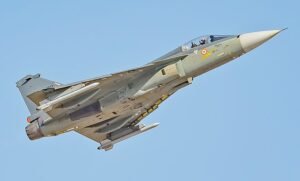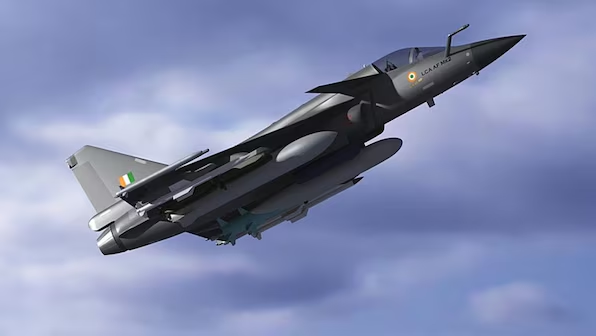Another step to increase Indian military strength after “ Operation Sindoor” India to receive new fighter jet with
Israeli tech after Pakistan conflict…….!

Recent news about “HAL Tejas”
The Indian Air Force is set to receive its new fighter jet, the HAL Tejas, later this month. The
delivery, delayed by more than a year, has become critical following the recent conflict with
Pakistan.
India’s decision to select a domestically produced aircraft to replace its aging MiG-21 and Jaguar
fighter jets is one of the reasons the country currently fields just 31 fighter squadrons instead of the
planned 42.
The Indian Air Force has already received 40 Tejas aircraft from the initial production run. Now, it
is set to receive the advanced A1 variant, which brings it closer to Western standards, largely thanks
to Israeli technology.
“ About technology use in Tejas ”
The Tejas is equipped with AESA (active electronic scanned array) technology made by Elta, a
subsidiary of Israel Aerospace Industries, replacing an earlier Israeli radar.
Elta is also providing an electronic warfare system. Pilots will use the latest helmet-mounted sight
from Elbit, while the planes will carry Rafael’s radar-guided Derby missile.
“Active Electronic Scanned Aaray (AESA)Technology”
AESA is a radar system where:
• The radar beam is steered electronically, not physically.
• Thousands of tiny transmit/receive (T/R) modules are embedded in the radar array.
• Each module independently transmits and receives radio signals.
• Beam direction can be changed in microseconds, allowing faster tracking of multiple targets.
Key Feature Of AESA Technology:
Feature Description:
• No Moving Parts Beam steering is done electronically, making the system more reliable and
faster.
• Multifunctional : It Can perform radar, electronic warfare (EW), and communication tasks
simultaneously.
• Low Probability of Intercept (LPI) , Harder to detect by enemy systems due to frequency
agility and low side lobes.
• High Resolution , Provides clearer target identification and tracking, even at long ranges.
• Multiple Target Tracking , Can track dozens or even hundreds of targets at once.
• Jamming Resistance, Resistant to electronic jamming due to agile beam control and
adaptive filtering.
Advantages of AESA .
• Instantaneous scanning over a wide area.
• Simultaneous tracking of multiple threats.
• High survivability and mission success rate.
• Compact design suitable for stealth platforms.
Indian perspective:
In context of technology and manufacturing chain :
Each of the aircraft ordered in the new variant will be fitted with multimillion-dollar Israeli systems
manufactured in India in partnership with local companies, in line with Indian Prime Minister
Narendra Modi’s “Make in India” policy, which requires local production of all defense
equipment.
Although India is still grappling with internal debates over buying foreign systems versus local
development, which is often criticized for poor quality. The Defense Ministry’s development arm in
New Delhi continues to nurture homegrown products, but the military often prefers imported,
higher-quality systems.
Meanwhile, Hindustan Aeronautics Ltd. is developing the next version of the Tejas, which will
feature canard wings for improved maneuverability, extended range, and enhanced systems. (Israeli,
French, and American companies are already vying to supply these systems.)
“Thus, the arrival of Tejas will lead to the development of latest technology in India, and India can
also increase its participation in the military product chain with latest technology. This will give
wings to India’s manufacturing sector.”
In context of millitary sector and education sector :
1. Research & Development (R&D):
If you’re in academia, DRDO, or a private R&D firm:
Join or collaborate with DRDO/LRDE: Institutions like DRDO’s Electronics and Radar
Development Establishment (LRDE) are developing indigenous AESA radars (e.g., Uttam AESA).
Work on core technologies:
Gallium Nitride (GaN) or Gallium Arsenide (GaAs) based T/R modules
RF system design
Beamforming algorithms
Radar signal processing
Publish research: Contribute to journals, conferences, or patent innovations in AESA-related
technologies.
2. Manufacturing & Industry Involvement
If you’re an entrepreneur, in defense manufacturing, or part of a startup:
Partner with DPSUs or DRDO to manufacture AESA subsystems like:
• T/R modules
• Radar control electronics
• Thermal management systems
• Antenna arrays
Apply for Make-in-India or iDEX schemes:
• The Indian Ministry of Defence promotes domestic innovation through iDEX, Make-II, and
SP (Strategic Partnership) models.
Develop supply chain: Localize supply of high-reliability components such as MMICs, PCBs,
power amplifiers, etc.
3. Education & Skill Development:
If you’re a student, professor, or training institute:
• Focus on radar and RF engineering in academic curricula.
• Set up specialized labs on microwave engineering, digital signal processing, and antenna
design.
• Promote internships and projects with DRDO, HAL, BEL, etc.
4. Policy & Strategic Support:
If you’re involved in policy, strategy, or defence procurement:
• Advocate for funding AESA R&D and faster induction in services.
• Streamline defence procurement policies to favor indigenous systems.
• Support export policies for Indian AESA-based systems (like the Uttam radar for LCA
Tejas).
• Promote private sector integration and joint ventures in radar technology.
5. Collaborate with Armed Forces:
• Work with IAF, Navy, and Army to identify evolving operational needs (e.g., long-range
tracking, anti-stealth capability).
• Participate in field trials and user feedback loops.
• Support retrofitting older platforms (e.g., MiG-29, Jaguar) with AESA systems.
6. Raise Awareness and Innovation:
• Organize or attend hackathons, defense expos, and tech summits.
• Promote AESA applications in civil sectors (air traffic control, meteorology, surveillance), to
scale production and reduce costs.
• Leverage AI/ML for AESA beamforming and target identification—an emerging field with
dual-use potential.

